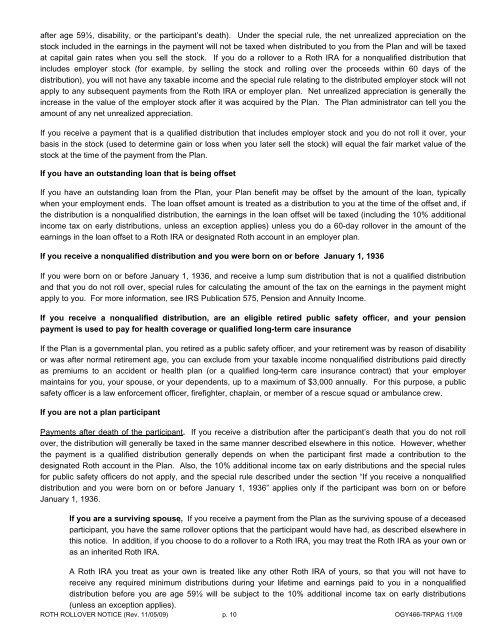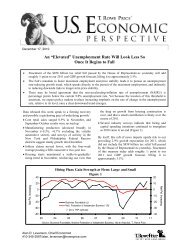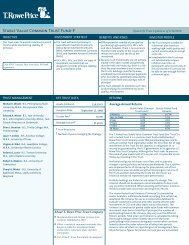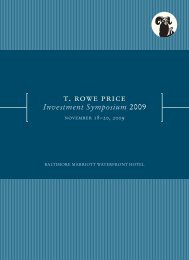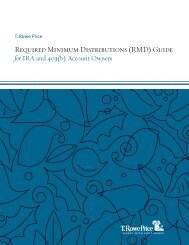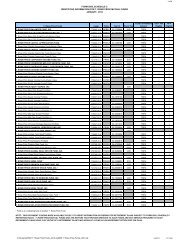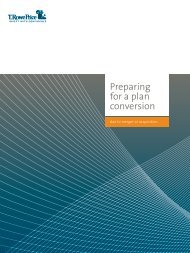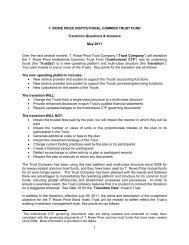YOUR ROLLOVER OPTIONS You are receiving this notice because ...
YOUR ROLLOVER OPTIONS You are receiving this notice because ...
YOUR ROLLOVER OPTIONS You are receiving this notice because ...
- No tags were found...
Create successful ePaper yourself
Turn your PDF publications into a flip-book with our unique Google optimized e-Paper software.
after age 59½, disability, or the participant’s death). Under the special rule, the net unrealized appreciation on the<br />
stock included in the earnings in the payment will not be taxed when distributed to you from the Plan and will be taxed<br />
at capital gain rates when you sell the stock. If you do a rollover to a Roth IRA for a nonqualified distribution that<br />
includes employer stock (for example, by selling the stock and rolling over the proceeds within 60 days of the<br />
distribution), you will not have any taxable income and the special rule relating to the distributed employer stock will not<br />
apply to any subsequent payments from the Roth IRA or employer plan. Net unrealized appreciation is generally the<br />
increase in the value of the employer stock after it was acquired by the Plan. The Plan administrator can tell you the<br />
amount of any net unrealized appreciation.<br />
If you receive a payment that is a qualified distribution that includes employer stock and you do not roll it over, your<br />
basis in the stock (used to determine gain or loss when you later sell the stock) will equal the fair market value of the<br />
stock at the time of the payment from the Plan.<br />
If you have an outstanding loan that is being offset<br />
If you have an outstanding loan from the Plan, your Plan benefit may be offset by the amount of the loan, typically<br />
when your employment ends. The loan offset amount is treated as a distribution to you at the time of the offset and, if<br />
the distribution is a nonqualified distribution, the earnings in the loan offset will be taxed (including the 10% additional<br />
income tax on early distributions, unless an exception applies) unless you do a 60-day rollover in the amount of the<br />
earnings in the loan offset to a Roth IRA or designated Roth account in an employer plan.<br />
If you receive a nonqualified distribution and you were born on or before January 1, 1936<br />
If you were born on or before January 1, 1936, and receive a lump sum distribution that is not a qualified distribution<br />
and that you do not roll over, special rules for calculating the amount of the tax on the earnings in the payment might<br />
apply to you. For more information, see IRS Publication 575, Pension and Annuity Income.<br />
If you receive a nonqualified distribution, <strong>are</strong> an eligible retired public safety officer, and your pension<br />
payment is used to pay for health coverage or qualified long-term c<strong>are</strong> insurance<br />
If the Plan is a governmental plan, you retired as a public safety officer, and your retirement was by reason of disability<br />
or was after normal retirement age, you can exclude from your taxable income nonqualified distributions paid directly<br />
as premiums to an accident or health plan (or a qualified long-term c<strong>are</strong> insurance contract) that your employer<br />
maintains for you, your spouse, or your dependents, up to a maximum of $3,000 annually. For <strong>this</strong> purpose, a public<br />
safety officer is a law enforcement officer, firefighter, chaplain, or member of a rescue squad or ambulance crew.<br />
If you <strong>are</strong> not a plan participant<br />
Payments after death of the participant. If you receive a distribution after the participant’s death that you do not roll<br />
over, the distribution will generally be taxed in the same manner described elsewhere in <strong>this</strong> <strong>notice</strong>. However, whether<br />
the payment is a qualified distribution generally depends on when the participant first made a contribution to the<br />
designated Roth account in the Plan. Also, the 10% additional income tax on early distributions and the special rules<br />
for public safety officers do not apply, and the special rule described under the section “If you receive a nonqualified<br />
distribution and you were born on or before January 1, 1936” applies only if the participant was born on or before<br />
January 1, 1936.<br />
If you <strong>are</strong> a surviving spouse. If you receive a payment from the Plan as the surviving spouse of a deceased<br />
participant, you have the same rollover options that the participant would have had, as described elsewhere in<br />
<strong>this</strong> <strong>notice</strong>. In addition, if you choose to do a rollover to a Roth IRA, you may treat the Roth IRA as your own or<br />
as an inherited Roth IRA.<br />
A Roth IRA you treat as your own is treated like any other Roth IRA of yours, so that you will not have to<br />
receive any required minimum distributions during your lifetime and earnings paid to you in a nonqualified<br />
distribution before you <strong>are</strong> age 59½ will be subject to the 10% additional income tax on early distributions<br />
(unless an exception applies).<br />
ROTH <strong>ROLLOVER</strong> NOTICE (Rev. 11/05/09) p. 10 OGY466-TRPAG 11/09


